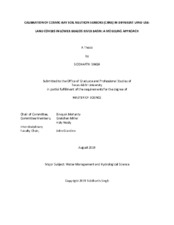| dc.contributor.advisor | Mohanty, Binayak | |
| dc.creator | Singh, Siddharth | |
| dc.date.accessioned | 2019-11-25T23:15:53Z | |
| dc.date.available | 2021-08-01T07:34:44Z | |
| dc.date.created | 2019-08 | |
| dc.date.issued | 2019-07-29 | |
| dc.date.submitted | August 2019 | |
| dc.identifier.uri | https://hdl.handle.net/1969.1/186596 | |
| dc.description.abstract | The cosmic-ray neutron sensors (CRNS) are a proximal sensor that can be used to estimate spatially averaged soil moisture at hectometer scale. The sensor measures the number of thermalized neutrons created by the collision between cosmic rays and atmosphere that interact with hydrogen atoms present in the environment and can be used to estimate soil moisture. However, extensive in-situ soil moisture measurements are needed to separate the signal of soil moisture from all other hydrogen pools such as aboveground biomass and atmospheric water content to calibrate the sensor. The objective of this study is to introduce a new technique of calibrating the sensor by evaluating water budget closures using CRNS and a calibrated sub-surface model Hydrus with minimal ground measurements. We installed CRNS at three sites in the Brazos river basin representing different land covers and management practices: i) traditional agriculture, ii) native prairie, and iii) managed prairie. The model was parameterized by inverting profile soil moisture information from just three locations in each land cover using the Shuffled Complex Evolution Algorithm in Hydrus-1D. The hydraulic parameters for the entire field were estimated by interpolating between the three locations to populate a Hydrus 2D model domain which was used to simulate the soil moisture distribution in the field. The CRNS was calibrated against the area average of modeled soil moisture distribution in the field. The calibrated dataset was able to capture the soil water budget at all the three sites with a water budget closure error of 0.01 m^3m^-3 -0.07 m^3m^-3 . The first part of validation was done by evaluating the calibrated output against intensively measured gravimetric soil moisture. We achieved acceptable values of RMSE (0.03m^3m^-3 - 0.06 m^3m^-3 ).For second part of validation we compare the evapotranspiration (ET) derived from Landsat thermal sensors and calibrated CRNS output. The ET from Landsat 8 was derived using METRIC algorithm which solves energy balance equation to provide the estimates. The values are calibrated against the reference ET acquired using Penman-Monteith equation. ET from CRNS is calculated using piecewise linear regression model. CRNS performed better than the Landsat-ET and has higher temporal resolution. The method reduces the labor in the regions where conducting field campaigns is difficult. Additionally, CRNS presents itself as a viable alternative to in-situ electromagnetic sensors in the clayey soil where the performance of these sensors is poor due to signal distortion. | en |
| dc.format.mimetype | application/pdf | |
| dc.language.iso | en | |
| dc.subject | CRNS | en |
| dc.subject | Lower Brazos River Basin | en |
| dc.subject | soil moisture | en |
| dc.subject | Hydrus | en |
| dc.subject | Landsat | en |
| dc.subject | METRIC | en |
| dc.title | Calibration of Cosmic-Ray Soil Neutron Sensors (CRNS) in Different Land Use-Land Covers in Lower Brazos River Basin: A Modeling Approach | en |
| dc.type | Thesis | en |
| thesis.degree.department | Biological and Agricultural Engineering | en |
| thesis.degree.discipline | Water Management and Hydrological Science | en |
| thesis.degree.grantor | Texas A&M University | en |
| thesis.degree.name | Master of Science | en |
| thesis.degree.level | Masters | en |
| dc.contributor.committeeMember | Miller, Gretchen | |
| dc.contributor.committeeMember | Neely, Haly | |
| dc.type.material | text | en |
| dc.date.updated | 2019-11-25T23:15:53Z | |
| local.embargo.terms | 2021-08-01 | |
| local.etdauthor.orcid | 0000-0001-8552-5081 | |


